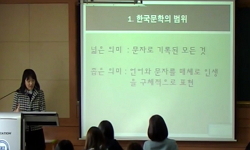유배가사는 유배 또는 유배적 상황에서 생성되는 유배자의 감정과 의사를 표현해 놓은 조선시대 시가의 한 유형으로서 16세기 초반에 처음 나타나 19세기 후반에 이르기까지 약 400여 년간 지...
http://chineseinput.net/에서 pinyin(병음)방식으로 중국어를 변환할 수 있습니다.
변환된 중국어를 복사하여 사용하시면 됩니다.
- 中文 을 입력하시려면 zhongwen을 입력하시고 space를누르시면됩니다.
- 北京 을 입력하시려면 beijing을 입력하시고 space를 누르시면 됩니다.
https://www.riss.kr/link?id=T7987486
- 저자
-
발행사항
광주 : 전남대학교 대학원, 2001
- 학위논문사항
-
발행연도
2001
-
작성언어
한국어
-
주제어
유배가사 ; exile gasa ; 가사
-
KDC
811.25 판사항(4)
-
DDC
895.71 판사항(20)
-
발행국(도시)
광주
-
형태사항
151p. : 삽도 ; 30cm.
-
일반주기명
지도교수: 김신중
참고문헌수록 - 소장기관
-
0
상세조회 -
0
다운로드
부가정보
국문 초록 (Abstract)
유배가사는 유배 또는 유배적 상황에서 생성되는 유배자의 감정과 의사를 표현해 놓은 조선시대 시가의 한 유형으로서 16세기 초반에 처음 나타나 19세기 후반에 이르기까지 약 400여 년간 지속되었다.
본고는 유배가사가 개별 작가들의 특수한 상황 및 체험에서 창작된 것이지만 시대의 흐름 및 문학사적 변화를 얼마만큼 수용하고 있는가에 관심을 두면서 표현 양상과 여기에 표출되고 있는 공통된 작가의식올 밝히고자 하였다. 아울러 이를 토대로 유배가사가 가지고 있는 문학사적 의의를 찾고자 하였다.
각 장에 논의한 내용의 요지는 다음과 같다.
I 장에서는 본고를 쓰게 된 목적과 기존의 연구사를 검토하면서 유배가사의 개념과 연구의 범위를 결정하였다.
II 장에서는 유배가사의 형성 배경을 크게 세 가지 측면에서 찾았다. 먼저 신라 때부터 있어 온 유배시가의 전통을 이어 받아 조선시대에 이르러 가사문학으로 크게 발전하였다고 보았다. 다음으로는 조선의 사회상과 사대부의 관계에서 고찰하였고, 또 개별 작가와 관계된 정치적 환경에서 그 배경을 찾았다. 여기서 작가와 관계 된 정치적 환경과 삶의 역정은 유배가사를 형성시킨 일차적 배경이 되었음올 확인하였다.
III 장에서는 유배가사의 체험 인식과 표현 양상에 대해 살펴보았다.
<만분가>를 비롯해 비교적 이른 시기에 지어진 작품들은 조선조 전기 사대부 특유의 관념 세계에 지배되어 유배라는 현상적 체험을 형상화함에 있어 적강모티프나 여성 화자와 같은 시적 장치를 동원해 체험 자체를 허구적으로 표현하였다. 그리고 대체로 후기에 지어진 유배가사는 경험 그 자체를 사실적으로 서술하고 있었다.
아울러 개별 작품에서 내용의 구성 방식과 정서의 표현 기법을 파악하는 데도 중점을 두었다. <사미인곡>과 <속미인곡>만이 유기적 구성 방식을 보여주고 있었으며,<만분가>와 <자도사> 그리고 <별사미인곡>은 병렬적 구성 방식을 취하고 있 었다. 그리고 <북관독>·<속사미인곡>·<만언사>·<북천가>·<채환재적가> 등 5편의 유배가사는 공간의 이동 및 시간의 순서에 따른 추보적 구성을 보이고 있었다.
또, 허구적 표현을 시도했던 작품에서 작가의 정서를 표현하는 기법으로 상징과 비유법을, 사실적 표현을 이루었던 작품에서는 열거와 반복법을 표현 기법상의 특징으로 지적하였다.
IV장에서는 유배가사의 유형과 여기에 나타나고 있는 작가의 의식 세계를 정리하였다.
먼저 작품에 설정된 화자 및 서술자가 현실에 대응하는 방식과 지향에 따라 연모형, 체념형, 비판형의 세 유형으로 분류하였다. 현실을 극복하려는 화자의 의지가 강하게 나타나면서 대상에 대한 연모의 정을 일관되게 표출하고 있는 <사미인곡>·<속미인곡>·<자도사>·<별사미인곡>·<속사미인곡>을 연모형으로, 그리고 연모형과 유사한 모습을 보이면서도 직·간접적으로 현실에 좌절하는 모습을 보이는 <만분가>와 <북관곡>을 체념형으로 보았다. 이 두 유형을 순응지향적 유배가사 라고 한다면 서술자의 가치에 반하는 부분에 대해 비판적 입장을 드러내는 작품을 비판형으로 분류하였다. 물론 이를 현실 개변을 지향하면서 비판 그 자체에 목적을 둔 완전한 비판의식이라고는 할 수 없지만 이 경우는 <만언사>.<북천가>.<채환재적가>에서 찾을 수 있었다.
이러한 각각의 유형에서 연군 의식, 숙명 의식, 사회 의식 등 세 가지의 작가 의식을 찾아냈다.
연군 의식은 모든 유배가사에 공통적으로 나타나는 의식으로서 이를 표출하는 방법은 임금의 권위와 존재에 대한 절대적 인식아래 작가 자신을 비하하거나 역사적 인물 및 자연물의 이미지를 통해 표출하고 있었다. 숙명 의식은 '人名은 在天' 이라는 천명론적 인생관에서 비롯된 것으로 정리하였다. 사회 의식은 작가가 현실 개변을 염두에 둔 적극적 비판이라기보다는 자신의 가치에 반하는 정치적 상황이나 유 배지의 풍속 등에 대해 비판적 입장을 드러내는 데서 찾아보았다.
V 장에서는 유배가사의 의의를 규명하였다.
유배가사의 문학사적 의의로 첫째, 유배가사는 작가 개인의 의사를 간곡하게 표현하고 있다는 점에서 삶과 밀착된 생활의 문학이었다. 둘째, 유배가사는 작가 및 독자의 관계에서 계층간 혹은 남녀간의 거리를 좁혀줌으로써 조선시대 시가 문학의 저변화에 기여했다. 셋째, 유배가사는 후기에 이르면서 시대와 문학사 전반의 변화를 충분히 수용하여 서술의 영역을 넓혀가면서 가사의 장편화 내지는 산문화를 유도하였다. 따라서 유배가사의 변모 양상이 곧 가사 전반의 변모 양상을 반영하고 있다는 의의를 지니고 있는 것으로 보았다.
VI장은 결론으로서 지금까지의 서술 내용에 대한 요약 정리와 함께 본고의 한계 및 앞으로의 과제를 언급하였다.
다국어 초록 (Multilingual Abstract)
Exile Gasa which expressed the emotion and opinion of the exile formed a type of poetical composition of the Chosun period. It was maintained from beginning of the 16th century to the late 19th century. This study is concerned about some degree accep...
Exile Gasa which expressed the emotion and opinion of the exile formed a type of poetical composition of the Chosun period. It was maintained from beginning of the 16th century to the late 19th century.
This study is concerned about some degree accept that Exile Gasa created in particular conditions and experience and common idea of each writer.
I tried to explore expression structure and common consciousness of Exile Gasa writers. Also, I tried to seek the meaning of literature history of Exile Gasa on the basis of literature study.
The subjects of this paper is as follows.
Chapter I, the concepts of Exile Gasa and boundary of this study was setted on the basis of literature study.
Chapter II, I observed form backgrounds of Exile Gasa in the large three sides. First of all, I think that exile poetic songs existed from Silla period influenced to the growing of Exile Gasa of Chosun periods. In this process, social ethics of Chosun and political structure of Sadebu playa critical role of Exile Gasa.
Chapter III, I examined the recognition of experience and the type of expressional appearance in Exile Gasa.
The Exile Gasa written in the relatively earlier period, including <Manbunga>, expressed as fictional which is real experience itself, using the poetic emotional mechanism such as hostile motive and female talker, in the formation process the real experience of exile, under the specific conditions which were controlled by ideology of Sadaebu in that time. Exile gasa written in the latter period described the experience realistically as itself.
I also emphasized on the establishment of content composition and technique of the emotional expression in an each individual article.
Only <Samiingok> and <Sokmiingok> showed the functional composition, <Manbunga>, < Jadosa>, and <Pyeolsamiingok> showed the parallel composition. Five Exile gasa - <Bukgoangok>, <Soksamiingok>, <Maneansa>, <Pukcheanga>, <Chaihwanjajugga>- showed step by step composition according to the movement of space and sequence of time.
The articles related to fictional expression showed the symbols and comparisons, and the articles related to realistic expression showed the enumeration and repetition as expression technique.
Chapter IV, I explored the types of Exile Gasa and the writers' conscious aspect.
First, the writers was classified into three types according to their cognitional methods to real world. First types of Exile Gasa such as <Samiingok>, <Sokmiingok>, < Jadosa>, <Pyeolsamiingok>, and <Soksami-ingok> were classified into type I (Love for the King) due to its structural characteristics which express the love for the King. And, <Manbooga> and <Buk goangok> were classified into type II(Renunciation) due to its content which espress renunciation to the real world. Lastly, <Maneansa>, <Pukcheanga>, and <Chaihwanjajugga> were classified into type III (Criticism), because those poetries were pursuit criticism on the real world. In particular, those works were stressed the reformation of real world.
Love pattern of Gasa about the king was written as accepted exile circumstance as a notion, experience as such expressed fictionally. Exile Gasa that was written in the latter period classified as critical pattern represented experience as such realistically. I put emphasis on the grasp that deployed development of method and technique of feature in the each work. Because of absolute recognition to the king, the expressed method of this feeling shows the thought disdained of writer's himself and the image of natural world. Destiny pattern arranged one's view of life of Heaven's will connected with Heaven's thought. Critical pattern put in order critical standpoint that expose political conditions against one's own self and customs of a place of exile. Therefore writer gives no thought the actual innovation.
Chapter V, The meaning of Exile Gasa was discussed. First, Exile Gasa was living literature in that it expressed writer's intents so sincerely. Second, Exile Gasa contributed to generalization of poetry literature of Chosun dynasty in that it was possible to narrow gaps among classes and sexes. Third, it is possible to investigate changing patterns of Gasa from Exile Gasa, its historical meanings should not be ignored. The Exile Gasa was contributed to structural characteristics of Gasa, because it encompassed changing patterns of periodical and historical characteristics of late Chosun.
Chapter VI, To conclude, I perceive the sense of the history of literature that Exile Gasa carried and the controversial point of this paper that I refer to a question hereupon.
목차 (Table of Contents)
- 목차
- <국문초록> = iii
- I. 序論 = 1
- 1. 연구의 목적 및 연구사 검토 = 1
- 2. 유배가사의 개념과 연구 대상 = 6
- 목차
- <국문초록> = iii
- I. 序論 = 1
- 1. 연구의 목적 및 연구사 검토 = 1
- 2. 유배가사의 개념과 연구 대상 = 6
- II. 流配歌辭의 형성 배경 = 12
- 1. 유배시가의 전통과 가사문학 = 12
- 2. 조선의 사회상과 사대부 = 17
- 3. 작가의 정치적 환경과 생애 = 20
- III. 流配歌辭의 체험 인식과 표현 양상 = 29
- 1. 체험의 형상화 양상 = 29
- 1) 관념의 세계와 허구적 표현 = 30
- 2) 경험의 세계와 사실적 서술 = 42
- 2. 내용의 구성 방식 = 64
- 1) 유배가사의 구성 = 64
- 2) 유기적 구성 = 66
- 3) 병렬적 구성 = 70
- 4) 추보적 구성 = 74
- 3. 정서의 표현 기법 = 79
- 1) 상징과 비유 = 80
- 2) 열거와 반복 = 90
- IV. 流配歌辭의 유형별 작가 의식 = 98
- 1. 연모형과 연군 의식 = 98
- 1) 임의 절대화 = 101
- 2) 충절의 관습적 표방 = 106
- 2. 체념형과 숙명 의식 = 113
- 1) 현실의 좌절과 체념 = 114
- 2) 천명론적 인생관 = 116
- 3. 비판형과 사회 의식 = 119
- 1) 정치적 상황에 대한 비판 = 121
- 2) 풍속과 사회 현실의 관찰 = 127
- V. 流配歌辭의 의의 = 134
- VI. 結論 = 139
- 참고문헌 = 143
- ABSTRACT = 149











